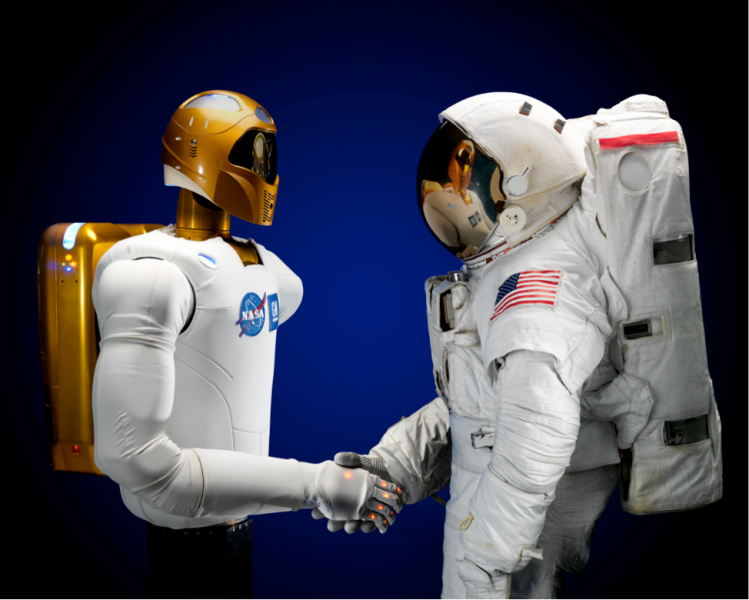Crowdsourcing is a hot topic right now. Well-known companies have been crowdsourcing for some time now, with the most active crowdsourcing adopters of the past ten years being Coca-Cola, PepsiCo, and Danone. More recently Procter & Gamble, Unilever, and Nestlé were named as the top three in 2013 and 2014 (eYeka). Brands are becoming less ashamed of looking to their own consumers for financial assistance.
Recently, one of the most aspirational and inspirational brands in the world has looked to the crowd for help on a number of fronts. That out-of-this-world brand is NASA.
Four weeks ago, NASA’s Center of Excellence for Collaborative Innovation (CoECI), through the NASA Tournament Lab (NTL), chose to partner with Freelancer.com to help design a number of CAD models for tools to be used in testing the Robonaut 2 (R2) robotic astronaut assistant.
This partnership was a test to see if great 3D design work could be done quickly and cheaply using crowdsourcing contests. The result has worked well with Steven Rader, deputy manager of CoECI, stating, “The Freelancer community has really responded enthusiastically with some amazing submissions.” He also added, “The number and quality of submissions that we have received have far exceeded our expectations. The 3-D models that we are receiving are truly photo-realistic and engineering-accurate models.”
These first challenges proved the validity of crowdsourcing as a viable option for NASA. Now NTL is becoming bold with two other contests, which are more challenging.
The first is a contest that asks freelancers to conceptualize Software Applications using NASA’s Delay/Disruption Tolerant Networking (DTN) Protocols. This involves creating innovative solutions for the Solar System Internet (SSI) based on the DTN technology, which will lead to the establishment of the Interplanetary Internet. NASA believes that finding new uses for this protocol could revolutionize how we can communicate on Earth, in space, and eventually from planet-to-planet. In the first three or four days of the contest being live, dozens of freelancers have submitted amazing solutions, ranging from providing device access in remote areas not normally served by networks, resilient transportation network safety monitoring systems, and systems for distress communications management. Many more are expected to enter the fray over the next three weeks. NASA may even buy several ideas to develop following the end of the contest.
The second contest, the NASA Challenge: Astronaut Smartwatch App Interface Design, is asking freelancers to design the smartwatch app for astronauts to use on the International Space station. Smartwatches have taken the world by storm, and it would seem very practical for each astronaut to have access to the status of the International Space Station’s systems easily accessible on their wrist.
NASA is asking freelancers to use the Samsung Gear 2 Watch as a hardware reference for the design, and the deliverables are wireframes highlighting navigation, interaction, layout, look, and feel.
The Astronaut Smartwatch app will be used for some of the following applications:
- Crew Timeline: Displays an agenda view of the space visit timeline as well as a way to easily navigate to another day in the past or future.
- Caution and Warnings: Displays color-coded cautions and warnings that will inform astronauts of what systems need attention and when.
- Communication Status: Displays whether or not the International Space Station is currently able to communicate with the ground through either voice or video.
- Timers: Sets timers for procedures or until the next activity. This general design should direct attention to the appropriate information for a task and increase efficiency.
- Provide appropriate feedback for actions: Must appear legible on the smaller Samsung Gear screen — innovative representations of data displayed on a Smartwatch is highly encouraged.
If the smartwatch design contest yields a successful design, NASA will then engage the freelancer community to develop the actual code for that application.
Some important lessons for employers that are planning on using crowdsourcing:
- Communicate clearly in the brief and provide clarification as you progress. Entrants want to produce high-quality work, and having a clear understanding is critical for coming up with the best design.
- Give specific feedback on what has been produced. We all know that the first submission will be just the start of the process. Contest posters must be honest about what has been produced and provide guidance for the designer.
- Post, learn, and refine. The more crowdsourcing you do, the more you figure out what works and what does not. It might be levels of detail in the brief, additional information, the prize fund, the duration of the contest, and other factors. Participant expectations evolve over time, so be sure to really listen to what the crowd wants to be a part of.
The DTN and Smartwatch challenges are another step forward in the evolution of learning the best approach for NASA to perform crowdsourcing. Rader said he expects many more crowdsourced engagements on Freelancer.com:
We have a number of contests that we are planning to run over the next few months. We are also planning to use contests to develop some project logos/patches for a few projects around the agency. There is also a really interesting challenge that we are working to put together to get high-resolution photographs of the ISS taken from ground-based telescopes by amateur astronomers. We will have a video that explains how to set up a tracking telescope and plan out the shot. This is a very different kind of challenge for the Freelancer community, and we are not sure it is going to work, but that is what this pilot is all about: testing the limits of what we can do with the crowd.
Exciting times for NASA, and doubly exciting for everyone that is getting involved in helping them innovate.
Nik Badminton is leading the charge of expanding Freelancer.com across USA and Canada. He writes and speaks about the future of work, the collaborative economy, and technology-driven innovations.


